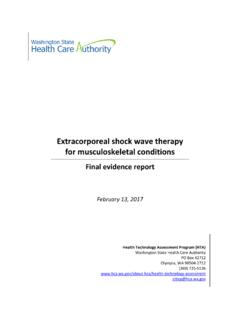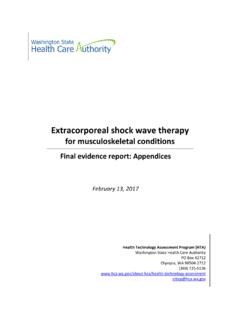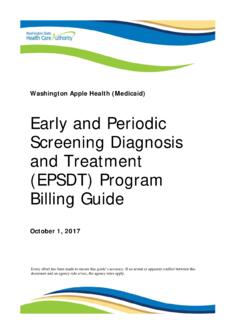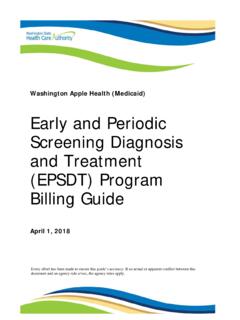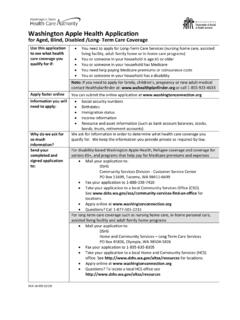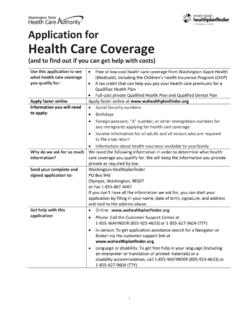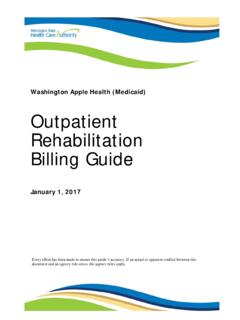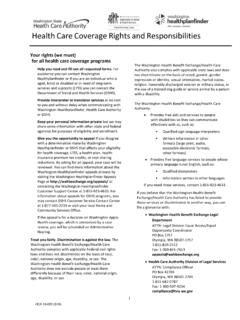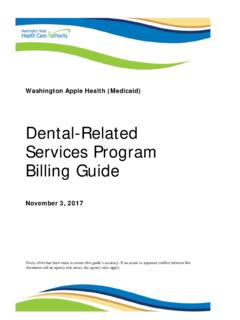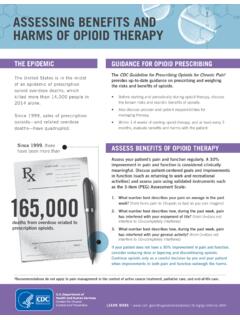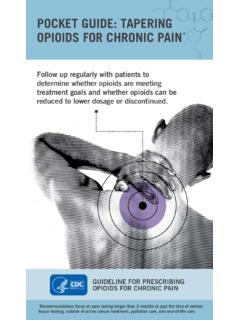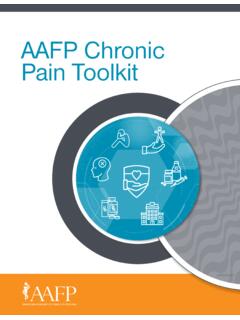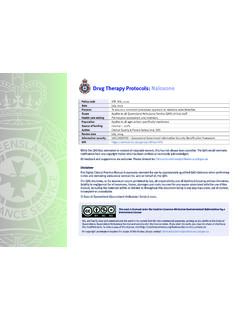Transcription of Analgesics: Opioid Agonists - Wa
1 Policy: Analgesics: Opioid Agonists Medical Policy No. Last Updated 03/31/2020 1 Analgesics: Opioid Agonists Medical policy no. Effective November 1, 2019 Note: For non-preferred agents in this class/category, patients must have had an inadequate response or have had a documented intolerance due to severe adverse reaction or contraindication to at least TWO* preferred agents. *If there is only one preferred agent in the class/category documentation of inadequate response to ONE preferred agent is needed If a new-to-market drug falls into an existing class/category, the drug will be considered non-preferred and subject to this class/category prior authorization (PA) criteria Background: The Opioid Agonists is a class of medications that is reserved for the treatment of severe pain that cannot be managed by non-pharmacologic therapies or other pharmacologic treatments.
2 Opioid Agonists provide analgesia by acting on Opioid receptors in the central and peripheral nervous systems that block the sensation of pain from signaling to the brain. Opioid Agonists are available in many dosage forms, including short-acting and long-acting formulations. Clinical policy: Drug Clinical Criteria (Initial Approval) Products approved by the FDA for the treatment of acute or chronic pain which contain one or more of these ingredients: benzhydrocodone buprenorphine (pain indications only) butorphanol codeine dihydrocodeine fentanyl hydrocodone hydromorphone levorphanol meperidine methadone morphine oxycodone oxymorphone pentazocine tapentadol tramadol Note: This criteria applies to all Opioid prescriptions.
3 Additional criteria applies to methadone, trans-mucosal fentanyl, and buprenorphine monotherapy. Please see their respective policies for the additional criteria: 1. Methadone: Policy 2. Transmucosal fentanyl: Policy 3. Buprenorphine for treating substance use disorder: Policy Note: Requests for codeine and tramadol for patients age 20 and younger requires medical justification for the use of codeine and tramadol rather than non-pharmacologic or non- Opioid medications in addition to the limits established below. Opioid prescriptions are covered to treat non-cancer, non-palliative care, non-hospice, and non-end of life related pain when the limits listed below are followed or when one of the exceptions applies. Opioid prescriptions exceeding the limits, which do not have an exception listed, but have unique circumstances supported by clinical judgement and documentation will be reviewed for authorization on a case-by-case basis.
4 Policy: Analgesics: Opioid Agonists Medical Policy No. Last Updated 03/31/2020 2 1. Maximum Daily Morphine Milligram Equivalent (MME): o Use of opioids is limited to 120 MME per day. o All single or combined Opioid claims that cumulatively exceed 120 MME per day but no more than 200 MME per day require consultation with a pain management specialist. See exceptions below. o All single or combined Opioid claims that cumulatively exceed 200 MME per day will be reviewed on a case-by-case basis for medical necessity. Chart notes, including a consultation with a pain specialist for the requested dose are required. See exceptions below. 2. Use of short-acting opioids for the treatment of acute pain (non-cancer, non-palliative care, non-hospice, and non-end of life) is subject to the following limits: o Dose limits: A quantity limit of 18 dosages per prescription for children ( 20 years of age) up to and including 120 MME per day; OR A quantity limit of 42 dosages per prescription for adults ( 21 years of age) up to and including 120 MME per day; AND o Days supply limits Up to and including 42 calendar days of Opioid use within a rolling 90-day period.
5 Use of any Opioid (s) for more than 42 days within a 90-day period is considered chronic use of opioids and requires prior authorization. See the chronic use of opioids section (#3) below; Note: Only short-acting opioids will be authorized for the treatment of acute pain. Long-acting opioids for acute use will only be authorized under the exception criteria below. 3. Use of opioids for the treatment of chronic pain (non-cancer, non-palliative care, non-hospice, and non-end of life) is subject to the following limits: o Maximum daily MME limited to 120 MME; and o Provider has submitted a signed Opioid Attestation Form attesting that the following criteria are met and are documented in the medical record: There is an ongoing clinical need for chronic Opioid use at the prescribed dose, not to exceed 120 MME per day Appropriate non- Opioid medications, and/or non-pharmacologic therapies are being used or have been ineffective Policy: Analgesics: Opioid Agonists Medical Policy No.
6 Last Updated 03/31/2020 3 For long acting opioids: patient has used short-acting opioids for at least 42 days or there is clinical justification why short-acting opioids are inappropriate or were ineffective. Baseline and on-going assessments of measureable, objective pain scores and function scores order to demonstrate clinically meaningful improvements in pain and function Results of periodic urine drug screens Provider has checked the prescription drug monitoring program for any other Opioid use and concurrent use of benzodiazepines or other sedatives Provider has discussed with patient the realistic goals of pain management therapy and has discussed discontinuation as an option during treatment. The provider confirms that the patient understands and accepts these conditions and the patient has signed a pain contract or informed consent document.
7 O Authorization will be for up to 12 months or the time period requested on the Opioid Attestation, whichever is less; o Opioid Attestation requests for chronic Opioid use will not be accepted until the patient has been on Opioid therapy for at least 25 days in a 90-day period. Note: Attestation must be signed by a prescriber who has written an Opioid prescription for this patient within the previous 90 days. Exceptions: 4. For patients with a diagnosis or pharmacy claim for active cancer treatment, hospice, palliative care, or end-of-life care o Prescriptions for greater than 18 dosages for children or greater than 42 dosages for adults for acute use of opioids are authorized for acute pain if the prescriber types or writes CANCER PAIN , HOSPICE , PALLIATIVE CARE , OR END OF LIFE CARE on the prescription.
8 O The pharmacy may submit the claim with the EA code 85000000540 to override the quantity limit and days supply, [this EA does not override the 120 MME limit (#1)]; o By indicating CANCER PAIN , HOSPICE , PALLIATIVE CARE , OR END OF LIFE CARE the provider acknowledges that the patient has a medically necessary need that requires the prescribed short-acting Opioid and it is documented in the medical record; o If the medical condition is provided to the pharmacy telephonically documentation must include the criteria met, who provided verification of the criteria, and the date the verification was provided. Example: a prescription should state, Policy: Analgesics: Opioid Agonists Medical Policy No. Last Updated 03/31/2020 4 cancer pain , hospice care , or palliative care diagnosis provided by Jane Doe at provider s office on MM/DD/YYYY; 5.
9 For patients with a medically necessary need other than cancer related pain, hospice care, palliative care, or end-of-life care o Prescriptions for greater than 18 dosages for children or greater than 42 dosages for adults for acute use of opioids are authorized for acute pain if the prescriber types or writes EXEMPT on the prescription. o The pharmacy may submit the claim with EA code 85000000541 [this EA does not override the 42 days chronic use limit (#3) or the 120 MME limit (#1)]; o By indicating EXEMPT the provider acknowledges that the patient has a medically necessary need that requires the prescribed short-acting Opioid [other than pain related to active cancer, hospice, palliative care, or end-of-life care] and it is documented in the medical record; o If the medical condition is provided to the pharmacy telephonically documentation must include the criteria met, who provided verification of the criteria, and the date the verification was provided.
10 Example: a prescription should state, cancer pain , hospice care , or palliative care diagnosis provided by Jane Doe at provider s office on MM/DD/YYYY; 6. For patients with a medically necessary need for a long-acting Opioid for treatment of acute pain o Prescriptions for long-acting opioids in the acute phase are authorized when the prescriber indicates CANCER PAIN , HOSPICE , PALLIATIVE CARE , OR END OF LIFE CARE on the prescription. The pharmacy may submit the claim with the EA code 85000000540 to override the quantity limit and days supply, [this EA does not override the 120 MME limit (#1)]; o Prescriptions for long-acting opioids in the acute phase are authorized when the prescriber types or writes EXEMPT on the prescription o The pharmacy may submit the claim with the appropriate EA [this EA does not override the 42 days chronic use limit (#3) or the 120 MME limit (#1)].
